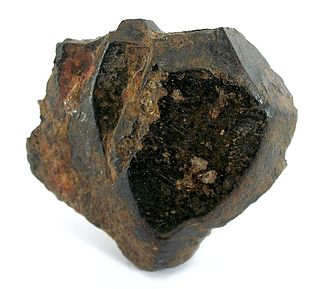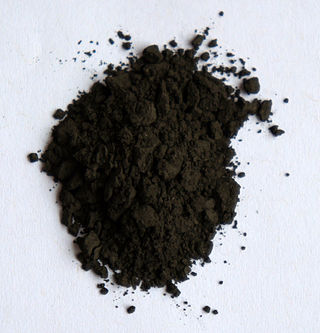Related Research Articles

Titanium is a chemical element; it has symbol Ti and atomic number 22. Found in nature only as an oxide, it can be reduced to produce a lustrous transition metal with a silver color, low density, and high strength, resistant to corrosion in sea water, aqua regia, and chlorine.

Ilmenite is a titanium-iron oxide mineral with the idealized formula FeTiO
3. It is a weakly magnetic black or steel-gray solid. Ilmenite is the most important ore of titanium and the main source of titanium dioxide, which is used in paints, printing inks, fabrics, plastics, paper, sunscreen, food and cosmetics.

Zirconium dioxide, sometimes known as zirconia, is a white crystalline oxide of zirconium. Its most naturally occurring form, with a monoclinic crystalline structure, is the mineral baddeleyite. A dopant stabilized cubic structured zirconia, cubic zirconia, is synthesized in various colours for use as a gemstone and a diamond simulant.

Steelmaking is the process of producing steel from iron ore and/or scrap. In steelmaking, impurities such as nitrogen, silicon, phosphorus, sulfur and excess carbon are removed from the sourced iron, and alloying elements such as manganese, nickel, chromium, carbon and vanadium are added to produce different grades of steel.

Titanium dioxide, also known as titanium(IV) oxide or titania, is the inorganic compound derived from titanium with the chemical formula TiO
2. When used as a pigment, it is called titanium white, Pigment White 6 (PW6), or CI 77891. It is a white solid that is insoluble in water, although mineral forms can appear black. As a pigment, it has a wide range of applications, including paint, sunscreen, and food coloring. When used as a food coloring, it has E number E171. World production in 2014 exceeded 9 million tonnes. It has been estimated that titanium dioxide is used in two-thirds of all pigments, and pigments based on the oxide have been valued at a price of $13.2 billion.

Industrial processes are procedures involving chemical, physical, electrical, or mechanical steps to aid in the manufacturing of an item or items, usually carried out on a very large scale. Industrial processes are the key components of heavy industry.

Titanium tetrachloride is the inorganic compound with the formula TiCl4. It is an important intermediate in the production of titanium metal and the pigment titanium dioxide. TiCl4 is a volatile liquid. Upon contact with humid air, it forms thick clouds of titanium dioxide and hydrochloric acid, a reaction that was formerly exploited for use in smoke machines. It is sometimes referred to as "tickle" or "tickle 4", as a phonetic representation of the symbols of its molecular formula.

Titanium diboride (TiB2) is an extremely hard ceramic which has excellent heat conductivity, oxidation stability and wear resistance. TiB2 is also a reasonable electrical conductor, so it can be used as a cathode material in aluminium smelting and can be shaped by electrical discharge machining.
A "photoelectrochemical cell" is one of two distinct classes of device. The first produces electrical energy similarly to a dye-sensitized photovoltaic cell, which meets the standard definition of a photovoltaic cell. The second is a photoelectrolytic cell, that is, a device which uses light incident on a photosensitizer, semiconductor, or aqueous metal immersed in an electrolytic solution to directly cause a chemical reaction, for example to produce hydrogen via the electrolysis of water.
The Hunter process was the first industrial process to produce pure metallic titanium. It was invented in 1910 by Matthew A. Hunter, a chemist born in New Zealand who worked in the United States. The process involves reducing titanium tetrachloride (TiCl4) with sodium (Na) in a batch reactor with an inert atmosphere at a temperature of 1,000 °C. Dilute hydrochloric acid is then used to leach the salt from the product.
The Kroll process is a pyrometallurgical industrial process used to produce metallic titanium from titanium tetrachloride. The Kroll process replaced the Hunter process for almost all commercial production.
The FFC Cambridge process is an electrochemical method for producing Titanium (Ti) from titanium oxide by electrolysis in molten calcium salts.

Carbothermic reactions involve the reduction of substances, often metal oxides (O2-), using carbon (C) as the reducing agent. The reduction is usually conducted in the electric arc furnace or reverberatory furnace, depending on the metal ore. These chemical reactions are usually conducted at temperatures of several hundred degrees Celsius. Such processes are applied for production of the elemental forms of many elements. The ability of metals to participate in carbothermic reactions can be predicted from Ellingham diagrams.
Titanium powder metallurgy (P/M) offers the possibility of creating net shape or near net shape parts without the material loss and cost associated with having to machine intricate components from wrought billet. Powders can be produced by the blended elemental technique or by pre-alloying and then consolidated by metal injection moulding, hot isostatic pressing, direct powder rolling or laser engineered net shaping.

Titanium hydride normally refers to the inorganic compound TiH2 and related nonstoichiometric materials. It is commercially available as a stable grey/black powder, which is used as an additive in the production of Alnico sintered magnets, in the sintering of powdered metals, the production of metal foam, the production of powdered titanium metal and in pyrotechnics.

Roasting is a process of heating a sulfide ore to a high temperature in the presence of air. It is a step in the processing of certain ores. More specifically, roasting is often a metallurgical process involving gas–solid reactions at elevated temperatures with the goal of purifying the metal component(s). Often before roasting, the ore has already been partially purified, e.g. by froth flotation. The concentrate is mixed with other materials to facilitate the process. The technology is useful in making certain ores usable but it can also be a serious source of air pollution.
The chloride process is used to separate titanium from its ores. The goal of the process is to win high purity titanium dioxide from ores such as ilmenite (FeTiO3) and rutile (TiO2). The strategy exploits the volatility of TiCl4, which is readily purified and converted to the dioxide. Millions of tons of TiO2 are produced annually by this process, mainly for use as white pigments. The chloride process has largely displaced the older sulfate process, which relies on hot sulfuric acid to extract iron and other impurities from ores.

Niobium dioxide, is the chemical compound with the formula NbO2. It is a bluish-black non-stoichiometric solid with a composition range of NbO1.94-NbO2.09. It can be prepared by reducing Nb2O5 with H2 at 800–1350 °C. An alternative method is reaction of Nb2O5 with Nb powder at 1100 °C.
The +4 oxidation state dominates titanium chemistry, but compounds in the +3 oxidation state are also numerous. Commonly, titanium adopts an octahedral coordination geometry in its complexes, but tetrahedral TiCl4 is a notable exception. Because of its high oxidation state, titanium(IV) compounds exhibit a high degree of covalent bonding.
Direct reduction is the fraction of iron oxide reduction that occurs in a blast furnace due to the presence of coke carbon, while the remainder - indirect reduction - consists mainly of carbon monoxide from coke combustion.
References
- ↑ Xia, Yang; Fang, Z. Zak; Zhang, Ying; Lefler, Hyrum; Zhang, Tuoyang; Sun, Pei; Huang, Zhe (2017). "Hydrogen Assisted Magnesiothermic Reduction (HAMR) of Commercial TiO2 to Produce Titanium Powder with Controlled Morphology and Particle Size". Materials Transactions. 58 (3): 355–360. doi: 10.2320/matertrans.MK201628 .
- ↑ Xia, Yang; Lefler, Hyrum D.; Zhang, Ying; Sun, Pei; Fang, Zhigang Zak (2020). "Hydrogen Assisted Magnesiothermic Reduction (HAMR) of TiO2 to Produce Titanium Metal Powder". Extractive Metallurgy of Titanium. pp. 165–179. doi:10.1016/b978-0-12-817200-1.00009-0. ISBN 9780128172001. S2CID 213342922.
- ↑ "asx.com.au, "TAO TO EXPLORE COMMERCIALIZATION OF LOW-CARBON, LOW-COST TITANIUM METAL POWDER IN THE USA"".